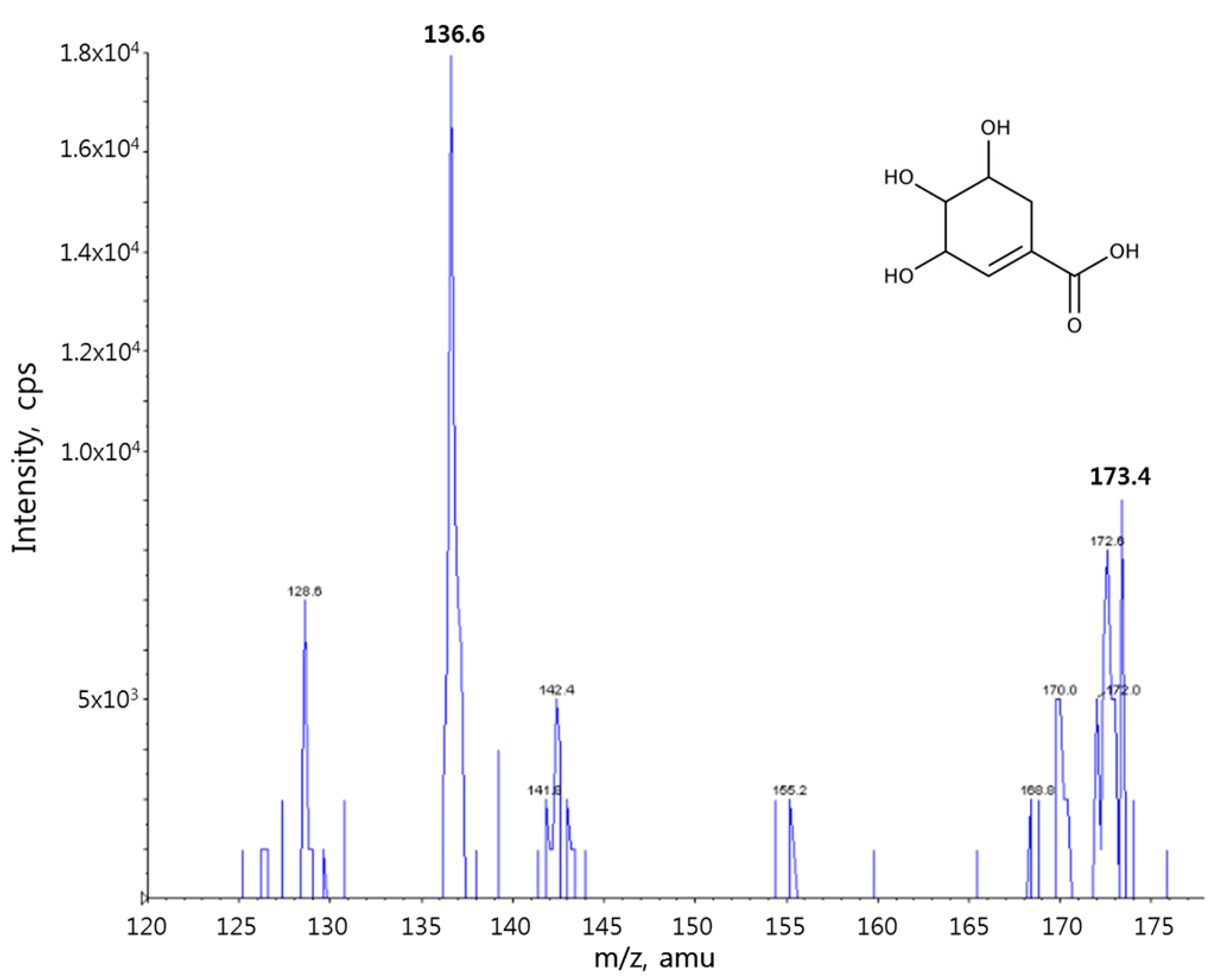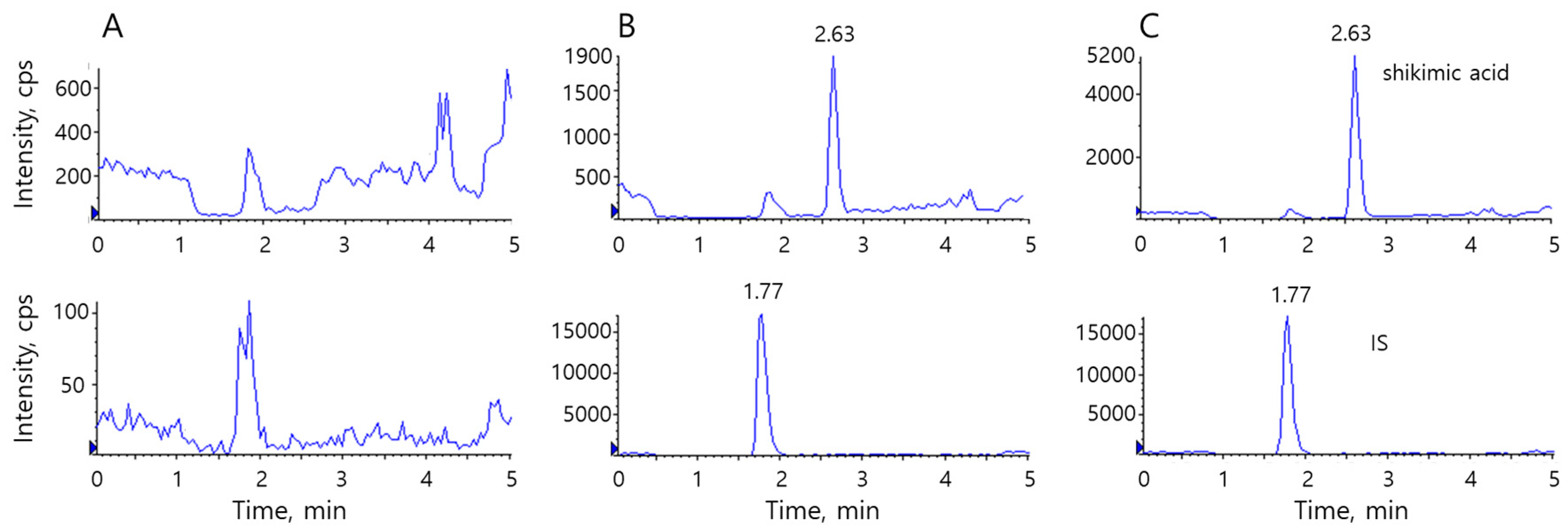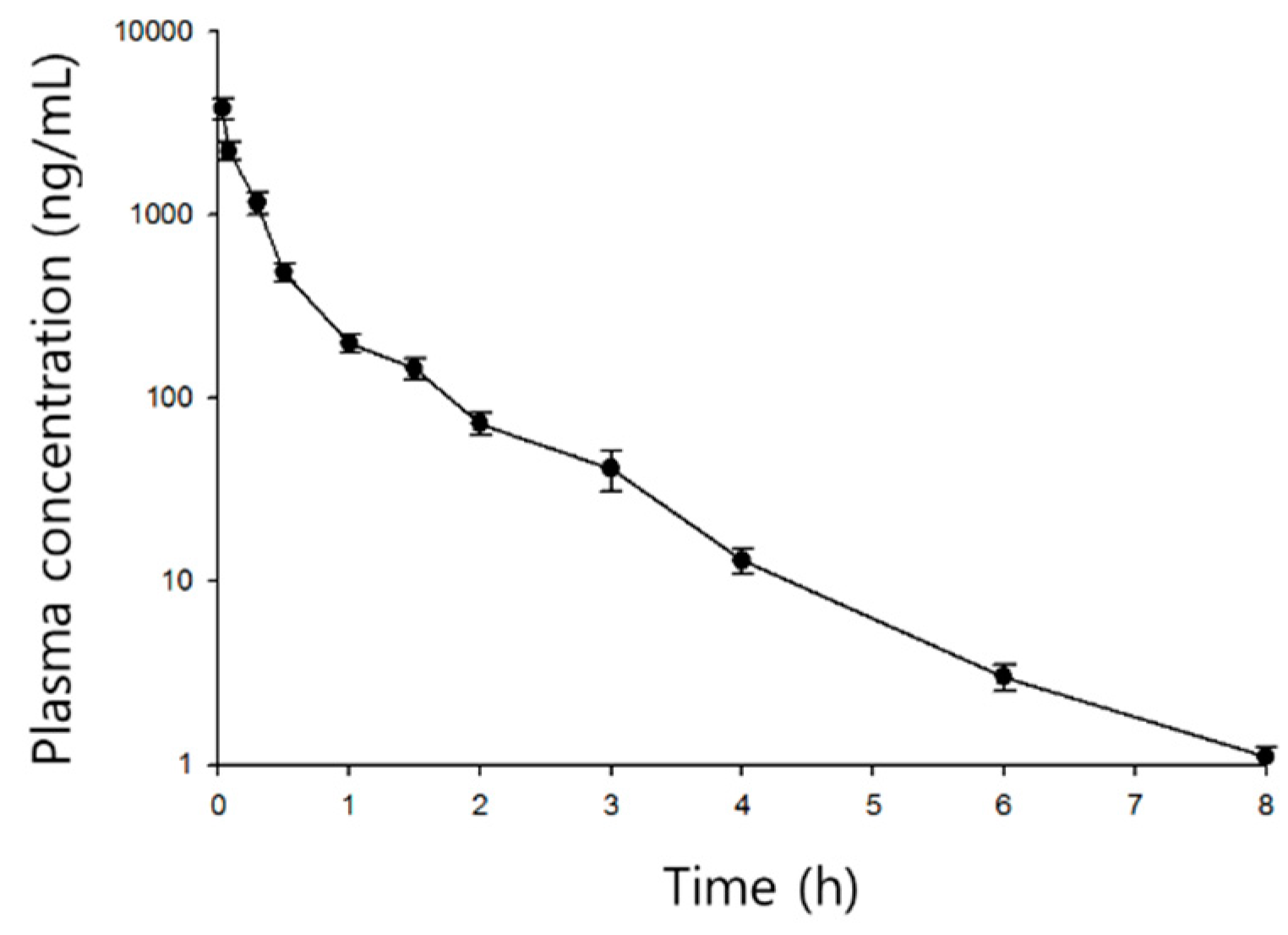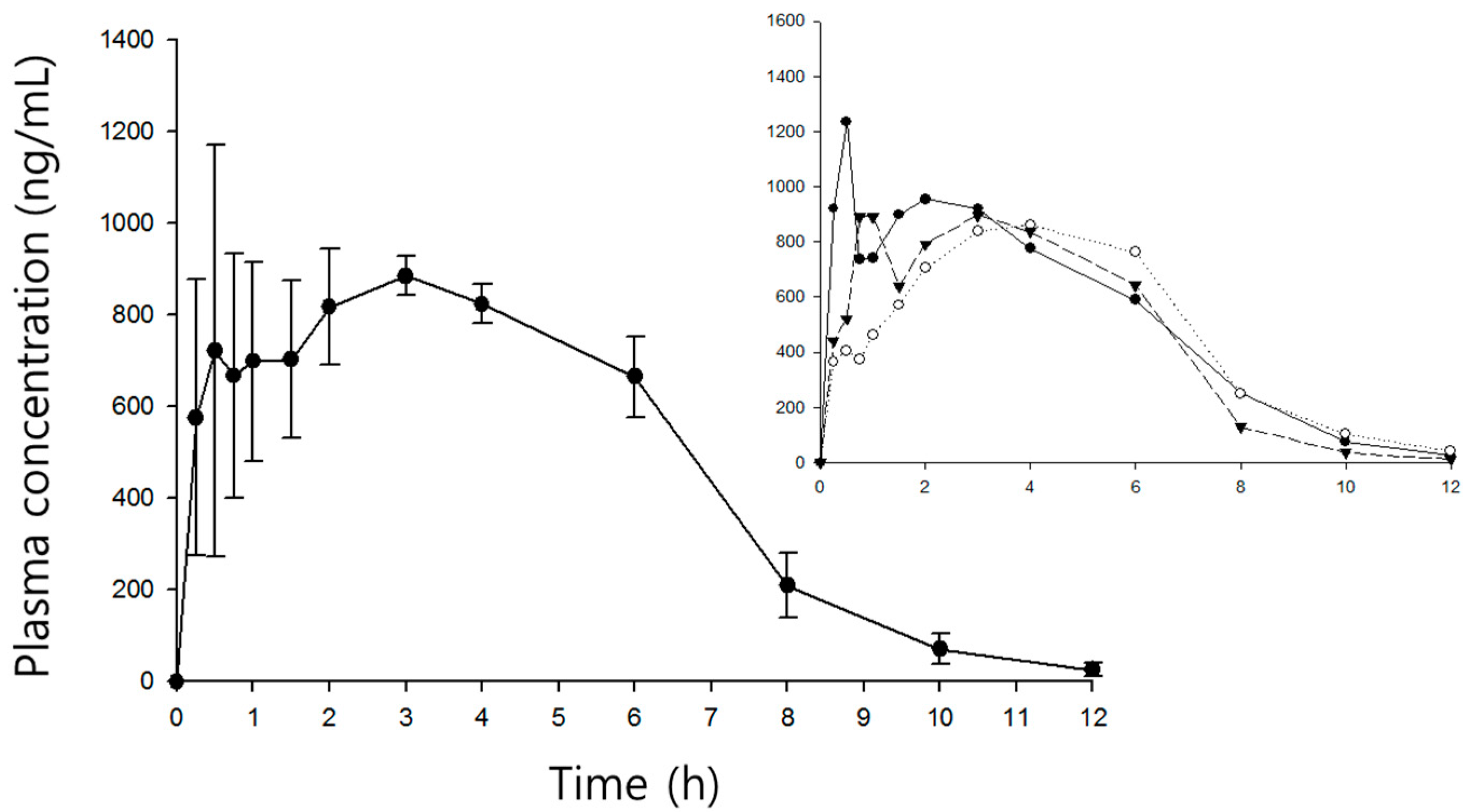Pharmacokinetics of Shikimic Acid Following Intragastric and Intravenous Administrations in Rats
Abstract
1. Introduction
2. Materials and Methods
2.1. Materials
2.2. Quantification of Shikimic Acid in Plasma
2.3. Method Validation and the Stability of Shikimic Acid
2.4. Animal Study
2.5. Pharmacokinetic Data Analysis
3. Results and Discussion
3.1. Validation of the Bioanalytical Method for Determining Shikimic Acid Levels in Rat Plasma
3.2. Time Courses of Plasma Shikimic Acid Concentrations Following Iv and Ig Administration
4. Conclusions
Author Contributions
Funding
Conflicts of Interest
References
- Bochkov, D.V.; Sysolyatin, S.V.; Kalashnikov, A.I.; Surmacheva, I.A. Shikimic acid: Review of its analytical, isolation, and purification techniques from plant and microbial sources. J. Chem. Biol. 2012, 5, 5–17. [Google Scholar] [CrossRef]
- Rawat, G.; Tripathi, P.; Saxena, R.K. Expanding horizons of shikimic acid. Appl. Microbiol. Biotechnol. 2013, 97, 4277–4287. [Google Scholar] [CrossRef] [PubMed]
- Barcellos, G.B.; Caceres, R.A.; de Azevedo, W.F., Jr. Structural studies of shikimate dehydrogenase from Bacillus anthracis complexed with cofactor NADP. J. Mol. Model. 2009, 15, 147–155. [Google Scholar] [CrossRef]
- Rabelo, T.K.; Guimarães, A.G.; Oliveira, M.A.; Gasparotto, J.; Serafini, M.R.; de Souza Araújo, A.A.; Quintans-Júnior, L.J.; Moreira, J.C.F.; Gelain, D.P. Shikimic acid inhibits LPS-induced cellular pro-inflammatory cytokines and attenuates mechanical hyperalgesia in mice. Int. Immunopharmacol. 2016, 39, 97–105. [Google Scholar] [CrossRef]
- Lu, F.; Yin, D.; Pu, Y.; Liu, W.; Li, Z.; Shao, Q.; He, C.; Cao, L. Shikimic Acid Promotes Oligodendrocyte Precursor Cell Differentiation and Accelerates Remyelination in Mice. Neurosci. Bull. 2019, 35, 434–446. [Google Scholar] [CrossRef]
- Choi, M.; Choi, S.J.; Jang, S.; Choi, H.I.; Kang, B.M.; Hwang, S.T.; Kwon, O. Shikimic acid, a mannose bioisostere, promotes hair growth with the induction of anagen hair cycle. Sci. Rep. 2019, 9, 17008. [Google Scholar] [CrossRef] [PubMed]
- Wang, M.; Wang, Y.; Omari-Siaw, E.; Wang, S.; Zhu, Y.; Xu, X. Reduced Burst Release and Enhanced Oral Bioavailability in Shikimic Acid-Loaded Polylactic Acid Submicron Particles by Coaxial Electrospray. J. Pharm. Sci. 2016, 105, 2427–2436. [Google Scholar] [CrossRef]
- Adamson, R.H.; Bridges, J.W.; Evans, M.E.; Willams, R.T. Specoes differences in the aromatization of quinic acid in vivo and the role of gut bacteria. Biochem. J. 1970, 116, 437–733. [Google Scholar] [CrossRef]
- Brewster, D.; Hones, R.S.; Parke, D.V. The metabolism of shikimate in the rat. Biochem. J. 1978, 170, 257–264. [Google Scholar] [CrossRef]
- Jensen, H.D.; Krogfelt, K.A.; Cornett, C.; Hansen, S.H.; Christensen, S.B. Hydrophilic carboxylic acids and iridoid glycosides in the juice of American and European cranberries (Vaccinium macrocarpon and V. oxycoccos), lingonberries (V. vitis-idaea), and blueberries (V. myrtillus). J. Agric. Food Chem. 2002, 50, 6871–6874. [Google Scholar] [CrossRef] [PubMed]
- Malalgoda, M.; Meinhardt, S.W.; Simsek, S. Detection and quantitation of immunogenic epitopes related to celiac disease in historical and modern hard red spring wheat cultivars. Food Chem. 2018, 264, 101–107. [Google Scholar] [CrossRef] [PubMed]
- Scalabrin, E.; Radaelli, M.; Capodaglio, G. Simultaneous determination of shikimic acid, salicylic acid and jasmonic acid in wild and transgenic Nicotiana langsdorffii plants exposed to abiotic stresses. Plant Physiol. Biochem. 2016, 103, 53–60. [Google Scholar] [CrossRef] [PubMed]
- Phillips, M.M.; Case, R.J.; Rimmer, C.A.; Sander, L.C.; Sharpless, K.E.; Wise, S.A.; Yen, J.H. Determination of organic acids in Vaccinium berry standard reference materials. Anal. Bioanal. Chem. 2010, 398, 425–434. [Google Scholar] [CrossRef] [PubMed]
- Al-Malki, A.I. Shikimic acid from Artemisia absinthium inhibits protein glycation in diabetic rats. Int. J. Biol. Macromol. 2019, 122, 1212–1216. [Google Scholar] [CrossRef] [PubMed]
- Zhang, Q.F.; Guo, Y.X.; Zheng, G.; Wang, W.J. Chemical constituents comparison between Rhizoma Smilacis Glabrae and Rhizoma Smilacis Chinae by HPLC-DAD-MS/MS. Nat. Prod. Res. 2013, 27, 277–281. [Google Scholar] [CrossRef] [PubMed]
- US Department of Health and Human Sevices. Guideline for Industry: Bioanalytical Method Validation; Food and Drug Administration: Bethesda, MD, USA, 2001.
- The Merck Publishing Group. The Merck Index, 14th ed.; The Merck Publishing Group: Darmstadt, Germany, 2006. [Google Scholar]
- Kang, W. Simple and sensitive determination of nisoldipine in plasma using liquid chromatography-tandem mass spectrometry. Anal. Sci. 2006, 22, 1597–1599. [Google Scholar] [CrossRef][Green Version]
- Yamamoto, S.; Hayasaka, F.; Deguchi, K.; Okudera, T.; Furusawa, T.; Sakai, Y. Absorption and plasma kinetics of collagen tripeptide after peroral or intraperitoneal administration in rats. Biosci. Biotechnol. Biochem. 2015, 79, 2026–2033. [Google Scholar] [CrossRef]
- Choi, S.; Kim, M.; Kim, C.; Hwang, J.K.; Kang, W. Quantitative determination of xanthorrhizol in rat plasma by HPLC-MS/MS and its application to a pharmacokinetic study. J. Pharm. Biomed. Anal. 2017, 132, 56–59. [Google Scholar] [CrossRef]
- Son, H.; Noh, K.; Kang, C.; Na, M.; Oh, S.; Song, I.S.; Kang, W. HPLC-MS/MS analysis of ilimaquinone and its application in a pharmacokinetic study in rats. J. Pharm. Biomed. Anal. 2019, 166, 291–294. [Google Scholar] [CrossRef]
- Son, H.; Kang, W. Quantitative determination of bilobetin in rat plasma by HPLC-MS/MS and its application to a pharmacokinetic study. Biomed. Chromatogr. 2020, 34, e4784. [Google Scholar] [CrossRef]
- Zamir, L.O.; Luthe, C. chemistry of shikimic acid derivatives. Synthesis of specifically labeled shikimic acid at C-3 or C-4′. Can. J. Chem. 1984, 62, 1169–1175. [Google Scholar] [CrossRef]
- Orhan, N.; Aslan, M.; Pekcan, M.; Orhan, D.D.; Bedir, E.; Ergun, F. Identification of hypoglycaemic compounds from berries of Juniperus oxycedrus subsp. oxycedrus through bioactivity guided isolation technique. J. Ethnopharmacol. 2012, 139, 110–118. [Google Scholar] [CrossRef] [PubMed]
- Ma, Y.; Xu, Q.P.; Sun, J.N.; Bai, L.M.; Guo, Y.J.; Niu, J.Z. Antagonistic effects of shikimic acid against focal cerebral ischemia injury in rats subjected to middle cerebral artery thrombosis. Acta Pharmacol. Sin. 1999, 20, 701–704. [Google Scholar]




| Concentration (ng/mL) | Intra-Day | Inter-Day |
|---|---|---|
| 5 | 98.3 ± 5.6 a (5.7) b | 97.4 ± 6.8 (7.0) |
| 30 | 102.2 ± 4.5 (4.4) | 98.6 ± 7.2 (7.3) |
| 500 | 103.5 ± 6.3 (6.1) | 102.5 ± 5.7 (5.6) |
| 3000 | 99.5 ± 6.4 (6.4) | 97.4 ± 5.6 (5.7) |
| Conditions for Stability Test | 100 ng/mL | 1000 ng/mL |
|---|---|---|
| room temperature for 4 h | 95.6 ± 4.5 a | 99.5 ± 5.2 |
| 3-cycle freeze-thaw | 106.5 ± 7.6 | 98.6 ± 6.2 |
| post-extraction at 4 °C for 24 h | 98.5 ± 5.4 | 95.3 ± 5.3 |
| −70 °C for 3 weeks | 110.5 ± 9.2 | 108.2 ± 8.3 |
| Parameter | Intra-Gastric (100 mg/kg) | Intravenous (2 mg/kg) |
|---|---|---|
| Cmax (ng/mL) | 904 ± 48 | - |
| Tmax (h) | 2.7 ± 1.5 | - |
| t1/2 (h) | 1.26 ± 0.20 | 1.12 ± 0.15 |
| AUCt (mg·h/L) | 5.76 ± 0.32 | 1.12 ± 0.06 |
| AUCinf (mg·h/L) | 5.81 ± 0.32 | 1.13 ± 0.06 |
| Cl (L/h/kg) | 1.73 ± 0.10 | 1.79 ± 0.09 |
| Vi (L/kg) | - | 0.51 ± 0.06 |
| Vss (L/kg) | - | 5.17 ± 0.67 |
| A (ng/mL) | - | 3500 ± 385 |
| α (h−1) | - | 5.57 ± 0.61 |
| B (ng/mL) | - | 387 ± 50 |
| β (h−1) | - | 0.78 ± 0.10 |
| bioavailability, F (%) | 10.4 | - |
© 2020 by the authors. Licensee MDPI, Basel, Switzerland. This article is an open access article distributed under the terms and conditions of the Creative Commons Attribution (CC BY) license (http://creativecommons.org/licenses/by/4.0/).
Share and Cite
Noh, K.; Back, H.-M.; Shin, B.S.; Kang, W. Pharmacokinetics of Shikimic Acid Following Intragastric and Intravenous Administrations in Rats. Pharmaceutics 2020, 12, 824. https://doi.org/10.3390/pharmaceutics12090824
Noh K, Back H-M, Shin BS, Kang W. Pharmacokinetics of Shikimic Acid Following Intragastric and Intravenous Administrations in Rats. Pharmaceutics. 2020; 12(9):824. https://doi.org/10.3390/pharmaceutics12090824
Chicago/Turabian StyleNoh, Keumhan, Hyun-Moon Back, Beom Soo Shin, and Wonku Kang. 2020. "Pharmacokinetics of Shikimic Acid Following Intragastric and Intravenous Administrations in Rats" Pharmaceutics 12, no. 9: 824. https://doi.org/10.3390/pharmaceutics12090824
APA StyleNoh, K., Back, H.-M., Shin, B. S., & Kang, W. (2020). Pharmacokinetics of Shikimic Acid Following Intragastric and Intravenous Administrations in Rats. Pharmaceutics, 12(9), 824. https://doi.org/10.3390/pharmaceutics12090824







